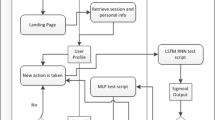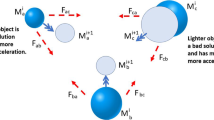Abstract
The incredible growth of telecom data and fierce competition among telecommunication operators for customer retention demand continues improvements, both strategically and analytically, in the current customer relationship management (CRM) systems. One of the key objectives of a typical CRM system is to classify and predict a group of potential churners form a large set of customers to devise profitable and targeted retention campaigns for keeping a long-term relationship with valued customers. For achieving the aforementioned objective, several churn prediction models have been proposed in the past for the accurate identification of the customers who are prone to churn. However, these previously proposed models suffer from a number of limitations which place strong barriers towards the direct applicability of such models for accurate prediction. Firstly, the feature selection methods adopted in majority of the past work neglected the information rich variables present in call details record for model development. Secondly, selection of important features was done through statistical methods only. Although statistical methods have been applied successfully in diverse domains, however, these methods alone without the augmentation of domain knowledge have the tendency to yield erroneous results. Thirdly, the previous models have been validated mainly with benchmark datasets which do not provide a true representation of real world telecom data consisting of noise and large number of missing values. Fourthly, the evaluation measures used in the past neglected the True Positive (TP) rate, which actually highlights the ability of a model to correctly classify the percentage of churners as compared to non-churners. Finally, the classifiers used in the previous models completely neglected the use of fuzzy classification methods which perform reasonably well for data sets with noise. In this paper, a fuzzy based churn prediction model has been proposed and validated using a real data from a telecom company in South Asia. A number of predominant classifiers namely, Neural Network, Linear regression, C4.5, SVM, AdaBoost, Gradient Boosting and Random Forest have been compared with fuzzy classifiers to highlight the superiority of fuzzy classifiers in predicting the accurate set of churners.







Similar content being viewed by others
References
Kawale, J., Pal, A., & Srivastava, J. (2009). Churn prediction in MMORPGs:A social influence based approach. In International conference on computational science andengineering, 2009. CSE’09 (pp.423–428).
Richter, Y., Yom-Tov, E., & Slonim, N. (2010). Predicting customer churn inmobile networks through analysis of social groups. In SDM, 2010(pp. 732–741).
Hung, S.-Y., Yen, D. C., & Wang, H.-Y. (2006). Applying data mining to telecom churn management. Expert Systems with Applications, 31, 515–524.
Tsai, C.-F., & Chen, M.-Y. (2010). Variable selection by association rules for customer churn prediction of multimedia on demand. Expert Systems with Applications, 37, 2006–2015.
Burez, J., & Van den Poel, D. (2009). Handling class imbalance in customer churn prediction. Expert Systems with Applications, 36, 4626–4636.
Song, G., Yang, D., Wu, L., Wang, T., & Tang, S. (2006). A mixed process neural network and its application to churn prediction in mobile communications. In Sixth IEEE international conference on data mining workshops, 2006. ICDM workshops 2006 (pp. 798–802).
Coussement, K., & Van den Poel, D. (2008). Churn prediction in subscription services: An application of support vector machines while comparing two parameter-selection techniques. Expert Systems with Applications, 34, 313–327.
Zhang, Y., Qi, J., Shu, H., & Cao, J. (2007). A hybrid KNN-LRclassifier and its application in customer churn prediction. In IEEE internationalconference on systems, man and cybernetics, 2007. ISIC (pp. 3265–3269).
Xia, G.-E., & Jin, W.-D. (2008). Model of customer churn prediction on support vector machine. Systems Engineering-Theory & Practice, 28, 71–77.
Hadden, J., Tiwari, A., Roy, R., & Ruta, D. (2006). Churn prediction usingcomplaints data. In Proceedings of world academy of science,engineering and technology.
Owczarczuk, M. (2010). Churn models for prepaid customers in the cellular telecommunication industry using large data marts. Expert Systems with Applications, 37, 4710–4712.
Huang, B. Q., Kechadi, T.-M., Buckley, B., Kiernan, G., Keogh, E., & Rashid, T. (2010). A new feature set with new window techniques for customer churn prediction in land-line telecommunications. Expert Systems with Applications, 37, 3657–3665.
Tsai, C.-F., & Lu, Y.-H. (2009). Customer churn prediction by hybrid neural networks. Expert Systems with Applications, 36, 12547–12553.
Wei, C.-P., & Chiu, I.-T. (2002). Turning telecommunications call details to churn prediction: A data mining approach. Expert Systems with Applications, 23, 103–112.
De Bock, K. W., & Van den Poel, D. (2011). An empirical evaluation of rotation-based ensemble classifiers for customer churn prediction. Expert Systems with Applications, 38, 12293–12301.
Huang, B., Buckley, B., & Kechadi, T.-M. (2010). Multi-objective feature selection by using NSGA-II for customer churn prediction in telecommunications. Expert Systems with Applications, 37, 3638–3646.
Verbeke, W., Martens, D., Mues, C., & Baesens, B. (2011). Building comprehensible customer churn prediction models with advanced rule induction techniques. Expert Systems with Applications, 38, 2354–2364.
Huang, Y., Zhu, F., Yuan, M., Deng, K., Li, Y., Ni, B. et al. (2015). Telco churn prediction with big data. In Proceedings of the 2015 ACM SIGMOD international conference on management of data (pp. 607–618).
Verbraken, T., Verbeke, W., & Baesens, B. (2014). Profit optimizing customer churn prediction with Bayesian network classifiers. Intelligent Data Analysis, 18, 3–24.
Maldonado, S., & Montecinos, C. (2014). Robust classification of imbalanced data using one-class and two-class SVM-based multiclassifiers. Intelligent Data Analysis, 18, 95–112.
Xie, Y., Li, X., Ngai, E., & Ying, W. (2009). Customer churn prediction using improved balanced random forests. Expert Systems with Applications, 36, 5445–5449.
Verbeke, W., Dejaeger, K., Martens, D., Hur, J., & Baesens, B. (2012). New insights into churn prediction in the telecommunication sector: A profit driven data mining approach. European Journal of Operational Research, 218, 211–229.
Author information
Authors and Affiliations
Corresponding author
Rights and permissions
About this article
Cite this article
Azeem, M., Usman, M. & Fong, A.C.M. A churn prediction model for prepaid customers in telecom using fuzzy classifiers. Telecommun Syst 66, 603–614 (2017). https://doi.org/10.1007/s11235-017-0310-7
Published:
Issue Date:
DOI: https://doi.org/10.1007/s11235-017-0310-7




